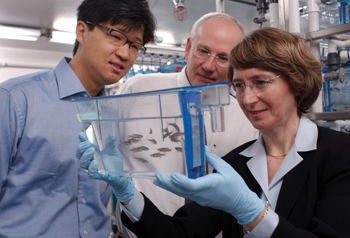
From left, Yong Cha, a graduate student, Raymond N. DuBois, M.D., Ph.D., and Lilianna Solnica-Krezel, Ph.D., take a closer look at some of the zebrafish they are studying.
photo by Dana Johnson
Study fishes out new role for prostaglandins

Fast-growing zebrafish are a staple in development research.
photo by Dana Johnson
Prostaglandins — the fat-derived compounds linked to pain, inflammation, reproduction and cancer — can add another biological function to their extensive catalog.
A new study by Vanderbilt researchers reveals that prostaglandins help choreograph the intricate cell movements during early embryonic development in zebrafish, highlighting how perturbations in this pathway might influence human development and the spread of cancer. The results also may point to new molecular targets for cancer prevention therapies.
The findings, published Jan. 1 in the journal Genes and Development, result from a cross-campus collaboration between the labs of Raymond DuBois, M.D., Ph.D., director of the Vanderbilt-Ingram Cancer Center, and Lilianna Solnica-Krezel, Ph.D., professor of Biological Sciences.
Early in development, vertebrate embryos consist of one layer of cells. These simple embryos must go through a complex reorganization called gastrulation to establish the three primitive layers from which all adult tissues develop — the innermost layer (endoderm), which forms the gut and associated digestive organs; the middle layer (mesoderm), which develops into muscle, bone and cardiovascular organs, and the outer layer (ectoderm), which becomes the skin and nervous system.
“The body is a tube in a tube in a shell,” Solnica-Krezel explained. “Before gastrulation, all of these prospective tubes are at the surface of the embryo. Gastrulation puts these different tissue precursors inside the embryo and gives them a proper shape.”
But little is known about the chemical signals that cause these cells to move. Previous studies in mice and zebrafish suggested that prostaglandins were important in development. Mice lacking an enzyme that synthesizes prostaglandins had numerous developmental defects, but the true effects of prostaglandins on the embryo were likely obscured by maternal prostaglandin production.
Because they develop outside the mother and are transparent, zebrafish embryos provide a unique model in which to examine prostaglandin's role in development.
Yong Cha, a graduate student in DuBois' lab and first author on the study, established a collaboration with zebrafish researcher Solnica-Krezel to study this process.
The researchers inhibited the production of a specific type of prostaglandin, PGE2, in zebrafish embryos and examined their development.
In embryos treated with the inhibitor, gastrulation was arrested or slowed down significantly. The resulting embryo was also shorter than an untreated embryo.
“What is spectacular,” said Solnica-Krezel, “is that…if you just put some prostaglandin back in the culture medium, you rescue the phenotype.”
In another set of embryos, the researchers blocked prostaglandin receptors, EP2 and EP4. Blocking the EP4 receptor caused defects similar to those associated with blocking PGE2 synthesis. When the researchers analyzed cell movement, they found that the shapes and trajectories of embryonic cells were normal — they simply moved much slower. This suggested that signaling through the EP4 receptor regulates the speed of cell movements during gastrulation.
These sluggish cell movements could upset development and spell the end for a developing embryo. But finding ways to exploit this pathway could have beneficial effects in cancer cells.
“The pathways important for regulating development are also dysregulated in cancer,” said DuBois, who studies prostaglandin signaling in colon cancer. Knowing how prostaglandins regulate cell movement in development can help cancer researchers determine how cancer cells spread, or metastasize — and how to stop the process.
Scientists have known that people who take aspirin, a drug that inhibits prostaglandin synthesis, have about a 50 percent reduction in their risk of getting colon cancer, DuBois explained.
“We've been on a quest for the last 10 years to understand why such a simple drug leads to such a significant reduction in cancer risk,” he said. “There are several parts to that puzzle. This (finding) may be one piece.”
Zebrafish models may seem like a step back from the more traditional mouse models used to study cancer. But zebrafish, which develop quickly, are inexpensive and easy to manipulate, could actually aid in the discovery of new cancer drugs.
“If you could use the zebrafish intelligently to screen for these drugs, it might really speed up the drug discovery process and give us some early clues about the effects we may see in humans,” DuBois said.
Other authors on the study were Seok-Hyung Kim and Diane Sepich in the Solnica-Krezel group, and F. Gregory Buchanan in the DuBois group. The research was supported by grants from the NIH, the T.J. Martell Foundation, the National Colorectal Cancer Research Alliance and the Zebrafish Initiative funded by the Vanderbilt University Academic Venture Capital Fund.













